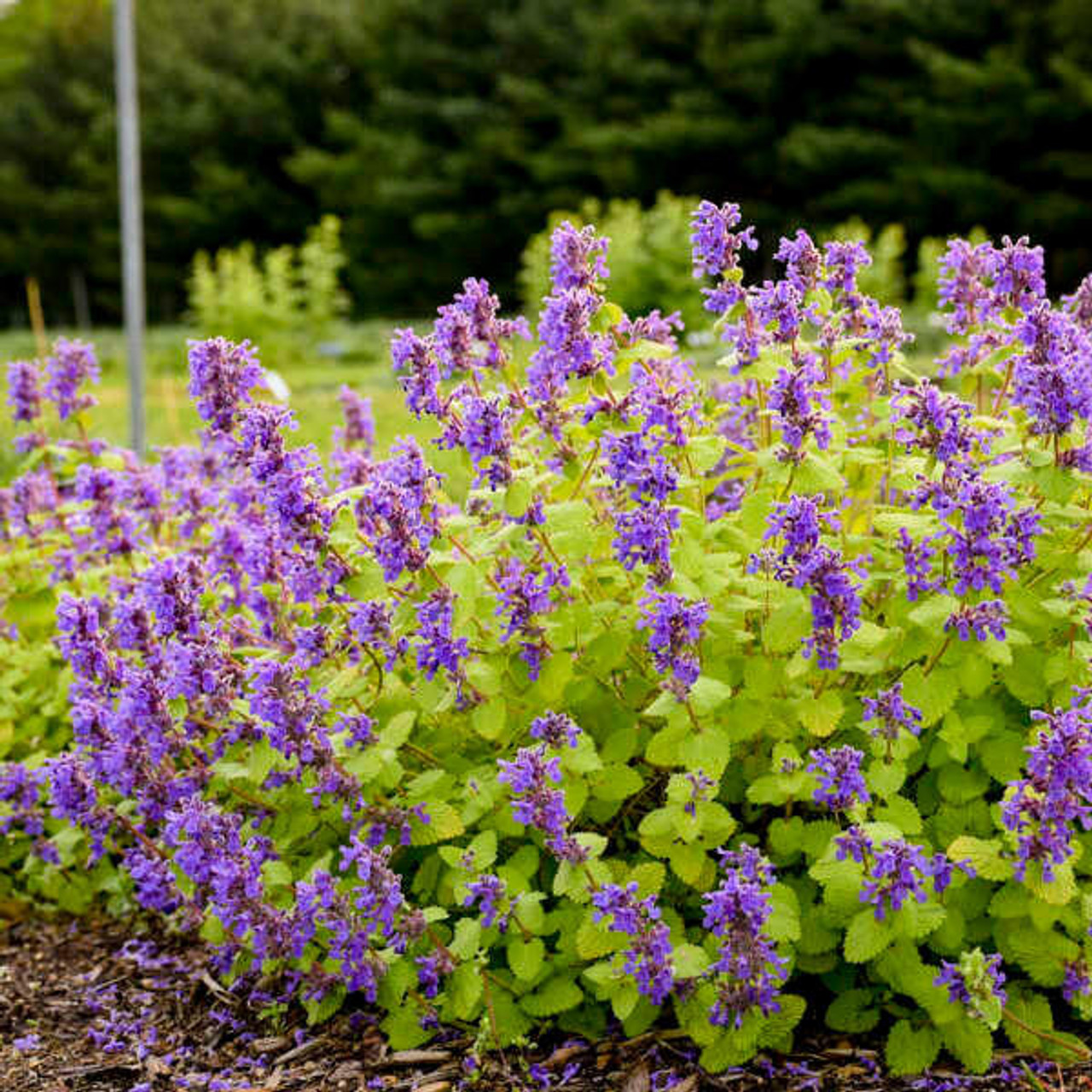Product Description
Nepeta 'Chartreuse on the Loose' PPAF (25) Bare Root Plants
Common Name: Catmint
'Chartreuse on the Loose' is a perennial with season long interest perfect for lining the front of the border. The foliage allows for a full three seasons of interest with bright chartreuse yellow leaves. Clusters of lavender blue flowers are produced just above the foliage and appear all summer long. Unlike most catmint, 'Chartreuse on the Loose' will continue to produce flowers without being cut back.
When Nepeta's stems are broken, they release an aroma into the air that tends to attract cats, thus its common name, Catmint.
Nepetas are easy to grow perennials that provide a beautiful show of color all summer long. They prefer to be planted in full sun and ordinary, well-drained soil. Shearing the plant back in the springtime will promote more compact growth. In addition, cutting plants back by half after their first bloom tends to stimulate a second bloom cycle.
Height: 8.0-10.0 Inches
Spread: 20.0-24.0 Inches
Hardiness Zones: 3,4,5,6,7,8
Flower Color: Blue shades
Foliage Color: Yellow shades
Full Sun (> 6 hrs. Direct Sun)
Low to Average Water Needs
Poor to Average Soil Quality
Bloomtime: Early Summer to Early Fall, Long Blooming
Attracts Butterflies and Hummingbirds
Bee Friendly
Deer and Rabbit Resistant
Growth Rate: Medium
Border Plant, Container, Cut Flower, Cut Foliage, Dried Flower, Drought Tolerant, Easy To Grow, Edging, Fragrant Flowers, Fragrant Foliage, Attractive Foliage, Mass Planting
Mature field grown plant shipped bare root.
Click here for more ordering and shipping information.
Nepeta first year bare root planting help?
Here is how to help your first-year bare root Nepeta (catmint) thrive:
Planting:
- Timing: Ideally, plant your bare root Nepeta in early spring or fall when the soil is cool and moist. However, if you are planting in July, choose a cloudy day or late afternoon to minimize heat stress.
- Location: Pick a spot with full sun to partial shade. Catmint prefers at least 6 hours of sunlight daily.
- Soil: Nepeta is adaptable to most soil types but thrives in well-draining soil. If your soil is heavy clay, amend it with compost or sand for better drainage.
- Planting process:
- Dig a hole 2-3 times wider and deeper than the root ball of your Nepeta.
- Gently loosen the roots of the plant, especially if they seem tightly packed.
- Place the Nepeta in the hole, ensuring the crown (the point where the roots meet the stem) sits slightly above the soil level.
- Backfill the hole with soil, tamping it down gently to remove air pockets.
- Water thoroughly to settle the soil around the roots.
Watering:
- Water your Nepeta regularly during the first year, especially during hot and dry periods. Aim to keep the soil consistently moist but not soggy.
- After the first growing season, Nepeta becomes quite drought tolerant and needs less frequent watering.
Additional care:
- Mulch: Apply a 2–3-inch layer of organic mulch around the base of the plant to retain moisture, suppress weeds, and regulate soil temperature.
- Fertilizer: Nepeta generally does not require heavy feeding. A light application of compost in the fall or a balanced fertilizer in spring is sufficient.
- Deadheading: To encourage continuous blooming, remove spent flowers (deadheading) throughout the season. Simply pinch off the flower heads just below where the flowers attach to the stem.
Bonus Tip: You can lightly trim your Nepeta by about a third after the first flush of flowers to promote bushier growth and potentially a second round of blooms.
By following these tips, your bare root Nepeta should establish itself well and reward you with beautiful fragrant flowers for years to come!
Other Details
The most important part of the plant is its root system. Healthy roots are the foundation of a healthy, vibrant plant. The type of plug container used is based on the specific needs of the plants. Perennials offered as bare root traditionally perform better when planted as bare root.Planted in a specialized mix, potted plants have well established root systems. Top growth stage will vary depending on the current life cycle and time of year when shipped. In Winter and early Spring dormant plants may be shipped. Dormant plants may be planted right away, even before the last frost date.
Most bare root varieties are field grown for at least one season, though Hemerocallis and Hosta are grown for two seasons. The bulk of the soil is removed during the harvesting process and the tops of most varieties are trimmed back to the crown. They are graded, packed in shredded aspen or sphagnum moss and stored in freezers until ready to be shipped.
See our Container Sizes and Bare Root Perennials pages for more information.
Plant information and care is provided in the Overview section, Plant Genus Page and general information is provided in the Planting Care & Guides. Additional questions can be asked on each Plant page.
Plant Spacing: Using the maximum mature spread or width of a plant to guide spacing, ensures space to grow to full size. To fill an area sooner, plant them closer together. Just remember, future thinning or transplanting may be needed.
Water: Keep a close eye on newly planted perennials, especially throughout the first growing year. Most early plant loss is due to too much or too little water!









